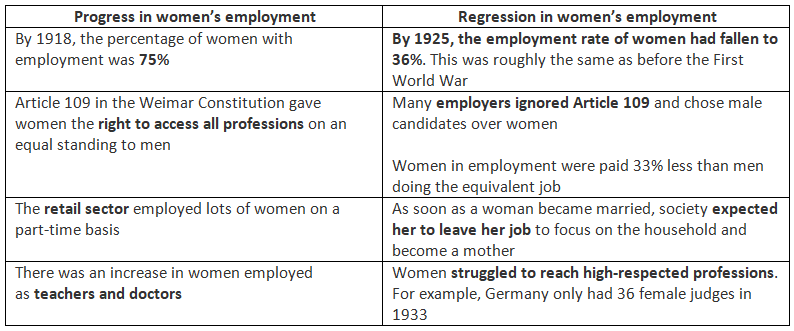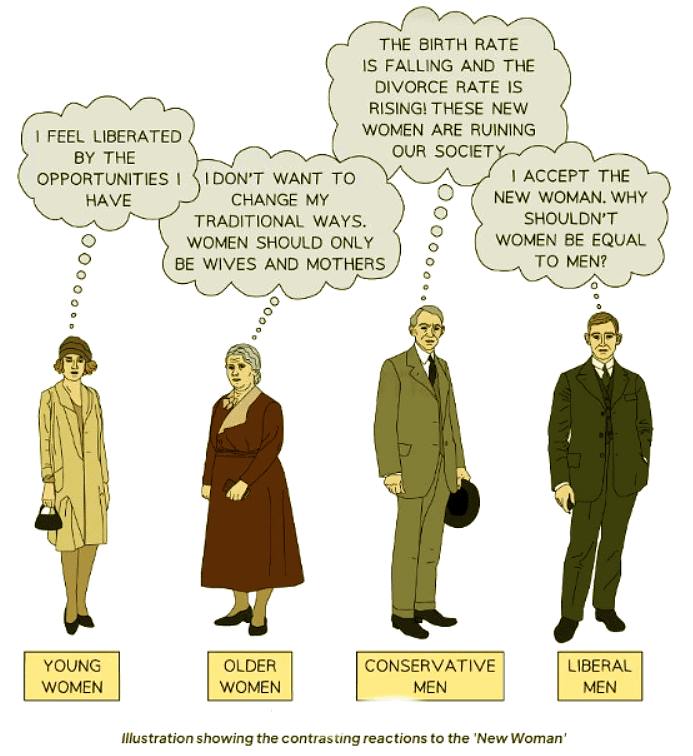Year 11 Exam > Year 11 Notes > History for GCSE/IGCSE > What were the Achievements of the Weimar Period?
What were the Achievements of the Weimar Period? | History for GCSE/IGCSE - Year 11 PDF Download
Was 1924-1929 a 'Golden Age' for the Weimar Republic? - Summary
- Historians disagree on how much the lives of citizens improved during the Weimar Republic.
- The 1920s in Weimar Germany saw a significant cultural boom. The Weimar government provided funding to artists and cultural institutions such as theatres and libraries, supporting rather than censoring innovative artistic approaches. New technologies like radio and film gave German artists new platforms to explore. This experimental culture angered many right-wing and extremist groups, as it conflicted with their traditional values.
- The creation of the Weimar Republic marked the start of the German welfare state, where the government aimed to support and enhance citizens' well-being. While there were successes, there was also a divide between urban and rural workers. Urban workers benefitted more from reforms, whereas agricultural workers suffered from high debt, low prices, and rising taxes, leading to a standard of living that by 1929 was 44% below the national average.
- Weimar Germany became a leader in advancing women's rights. The Weimar Constitution established universal suffrage, which was uncommon in Europe at the time. The right to vote and increased employment opportunities led to the emergence of the ‘New Woman’ in the 1920s—independent, career-oriented, and less interested in traditional roles of wife and mother, enjoying unprecedented freedoms.
- The progressive stance on women's rights in Weimar Germany faced significant opposition. The right-wing criticized the ‘New Woman’ for undermining traditional family values. Extremist groups, like the Nazi Party, campaigned to revert women to traditional roles as wives and mothers.
The 'Golden Age' of the Weimar Republic
Weimar Art
- Expressionism in Weimar Germany featured grotesque or exaggerated figures in violent scenes to make the audience feel uncomfortable, encouraging them to question their society.
- Otto Dix, a renowned New Objectivist artist in Weimar Germany, created paintings that highlighted the struggles of war veterans returning to Germany.
- George Grosz's painting ‘Grey Day’ used expressionism to depict the monotony of everyday life.
- Weimar art shocked the conservative upper classes and extreme right-wing groups.
- Traditionally, Germany's cultural output was controlled and produced by the more educated upper classes. However, in the Weimar Republic, they no longer held this power.
- The meanings of these artworks were often ambiguous, allowing for multiple interpretations.
- These artworks could have undermined the authority of the upper classes.
- Many artists held strong left-wing beliefs, which challenged the traditional values upheld by the right.
 Grey Day’ by George Grosz, 1921
Grey Day’ by George Grosz, 1921
Weimar Architecture
- In 1919, a new design movement called ‘Bauhaus’ emerged.
- Walter Gropius founded Bauhaus in Weimar Germany in 1919, aiming to create a unified style that integrated all art forms.
- The Bauhaus design school operated in three German cities—Weimar, Berlin, and Dessau—between 1919 and 1933.
- Notable lecturers at the Bauhaus College included artist Paul Klee and sculptor Oskar Schlemmer.
- ‘Bauhaus’ architecture utilized geometric shapes to create functional buildings, appreciating the beauty of technology and repurposing familiar materials in innovative ways, such as constructing entire buildings with concrete.
- The ‘Bauhaus’ movement influenced Weimar architects like Erich Mendelsohn.
- Erich Mendelsohn designed the Einstein Tower, an observatory in Potsdam, to resemble a rocket.
 Einstein Tower
Einstein Tower
Weimar Cinema
- Cinema became extremely popular in the 1920s. By 1929, there were approximately 500 cinemas throughout Germany.
- The film "The Cabinet of Doctor Caligari" (1920) is considered one of the pioneering horror movies. Directed by Robert Wiene, it introduced the concept of a 'plot twist' ending, a groundbreaking innovation in cinema history.
- F. W. Murnau's "Nosferatu" (1922) is renowned as the world's first vampire film. Murnau's innovative use of tension-building techniques in this movie has had a lasting impact on the horror genre. Many contemporary films continue to draw inspiration from his methods.
- "Metropolis" (1926), directed by Fritz Lang and funded by the Weimar government through an organization called UFA, was a significant modernist science-fiction film. It explored the theme of technology's influence on 20th-century life. Despite its initial lack of success, the film has served as a major influence on modern cinematic works like "Star Wars."
- In 1930, Germany produced its first talking film, also known as a 'talkie.' By 1932, around 3,800 German cinemas were equipped to screen films with sound, marking a pivotal moment in cinematic history.
 A scene from The Cabinet of Doctor Caligari (1920)
A scene from The Cabinet of Doctor Caligari (1920)
Weimar Nightlife
- Weimar Germany had a vibrant nightlife, especially in cities like Berlin, where people commonly engaged in:
- Watching cabaret performances
- Attending the theatre
- Dancing in nightclubs
- These activities fostered liberal behavior, with both women and men drinking, smoking, and engaging in sexual activities. Young Germans were notably open about their sexuality, and gay communities developed in the larger cities.
Changes to Living Standards
- During this period, both women and men engaged in behaviors such as drinking, smoking, and engaging in sexual activities.
- Youth in Germany exhibited a remarkable openness towards sexuality, a cultural shift that led to the formation of gay communities in major urban areas.
- To Enhance Quality of Life, Weimar Government Measures:
- Implemented the Unemployment Insurance Act in 1927
- This initiative financed insurance covering unemployment and sickness
- Approximately 16.4 million employees had 3% of their salaries redirected to the state
- For unemployed or unhealthy insured Germans, the system offered 60 Reichsmarks per week
- Enhanced Labor Conditions:
- Reduced weekly working hours from 50 in 1925 to 46 in 1927
- Real wages of workers surged by 25% from 1925 to 1928, factoring in living costs and inflation
- Emphasized Housing:
- Lands utilized foreign loans for construction ventures
- Introduced a 15% rent tax to establish building associations
- Private enterprises erected 37,000 new residences from 1925 to 1929
- During the same period, building associations built 64,000 homes
- Passed the Reich Pension Law:
- Over 1.3 million individuals (including widows and ex-soldiers) received war-related pensions
- Weimar Germany allocated roughly 40% of its GDP to this program
Changes to Women
- The Weimar Republic prioritized enhancing the quality of life for women.
- The Weimar Constitution legally granted women the right to vote, allowing all women above 21 to participate in elections, matching the voting rights of German men.
- Article 109 of the Constitution emphasized marriage as a legal partnership of equality between men and women.
- Women in Germany actively engaged in politics, with elections witnessing a high turnout of around 90% of female voters.
- In 1920, 111 women were elected as party representatives in the Reichstag, showcasing growing female political participation.
- The Weimar government implemented initiatives to enhance women's employment opportunities.

- The expansion of women's rights, including the right to vote and increased job opportunities, empowered women to express themselves freely.
- The emergence of the 'New Woman' led to significant shifts in societal norms and behaviors.
- These 'New Women' exhibited traits such as:
- Purchasing more revealing attire.
- Opting for shorter hairstyles.
- Using more makeup.
- Engaging in activities like smoking and drinking.
- Emphasizing their careers over traditional roles as wives and mothers.
- Businesses capitalized on the image of the 'New Woman' to market their products effectively.
- Cosmetic companies, in particular, employed this strategy to promote their goods.
Question for What were the Achievements of the Weimar Period?Try yourself: Which artistic movement emerged in Weimar Germany and challenged traditional values?View Solution
Criticism of the 'Golden Age'
- Extremists leveraged societal disdain for the 'New Woman' to bolster their ideologies.
- Hitler attributed rising unemployment rates among the working class to the 'New Woman'.
- He actively campaigned against the 'New Woman', advocating a return to traditional female roles in households.
- Trade unions exhibited negative sentiments towards women in the workforce.
- Men predominantly controlled trade unions.
- They feared that gender equality at work would harm male employees.
- They resented the concept of 'double earners' - households where both spouses worked.

Extremist Opposition to Weimar Culture
- Many extremist parties were opposed to Weimar culture.
- Extreme left-wing parties, such as the KPD, viewed the government's cultural funding as a waste of money, believing it diverted resources away from those in need, like the workers.
- Extreme right-wing parties, including the NSDAP, argued that Weimar culture was eroding German traditions and causing a moral decline in society.
- The Wandervögel movement protested against the societal progress of Weimar Germany, advocating for a return to traditional values.
The document What were the Achievements of the Weimar Period? | History for GCSE/IGCSE - Year 11 is a part of the Year 11 Course History for GCSE/IGCSE.
All you need of Year 11 at this link: Year 11
|
81 videos|86 docs|18 tests
|
FAQs on What were the Achievements of the Weimar Period? - History for GCSE/IGCSE - Year 11
| 1. Was 1924-1929 considered a 'Golden Age' for the Weimar Republic? |  |
Ans. During the years 1924-1929, the Weimar Republic experienced a period of economic stability, cultural innovation, and political cooperation, leading some historians to refer to it as a 'Golden Age' for the republic.
| 2. What were some changes to living standards during the 'Golden Age' of the Weimar Republic? |  |
Ans. During this period, living standards in Germany improved as the economy stabilized, unemployment decreased, and social welfare programs were implemented, leading to a better quality of life for many Germans.
| 3. What were some criticisms of the 'Golden Age' of the Weimar Republic? |  |
Ans. Critics argue that the economic prosperity of the era was built on unstable foundations, with heavy reliance on foreign loans and the Dawes Plan, leading to potential economic vulnerability in the future.
| 4. How did extremist opposition manifest towards Weimar culture during the 'Golden Age'? |  |
Ans. Extremist groups, such as the Nazis and Communists, opposed the Weimar Republic's culture of liberalism, democracy, and modernism, viewing it as a threat to their ideologies and seeking to undermine it through violence and propaganda.
| 5. What were some achievements of the Weimar period that contributed to its 'Golden Age' reputation? |  |
Ans. Some key achievements of the Weimar period include the establishment of a democratic government, advancements in art and culture known as the Weimar Renaissance, and economic stability and growth that improved the quality of life for many Germans.
Related Searches


















